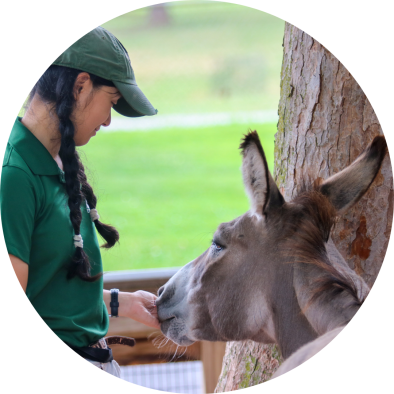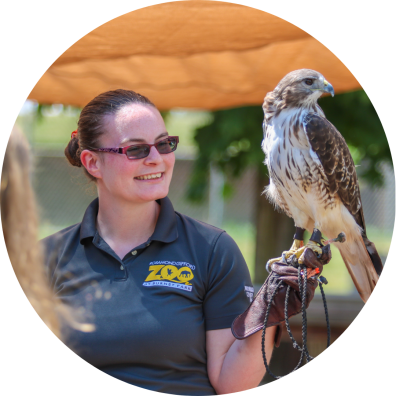Minimizing Stress and Maximizing Animal Welfare During Zoo Events
Promoting good animal welfare is, without a doubt, the top priority of both the Rosamond Gifford Zoo and the Friends of the Rosamond Gifford Zoo.

While the Rosamond Gifford Zoo handles animal care and maintenance operations, the Friends of the Zoo is a nonprofit organization that exists to provide financial support to the zoo through funds dedicated to the welfare of our animals, educational programs, and facilities. Although the main functions of the two groups are different, we come together over our shared missions to take the best possible care of over 1300 individual animals who live at the zoo and to conserve wildlife populations across the globe. Even during events hosted by the Friends of the Zoo that do not directly involve animals, the animals’ welfare and comfort are always addressed, monitored, and maintained so that the event adheres to our goal of wildlife conservation. When you attend popular events such as Holiday Nights, Brew at the Zoo, Zoo Run Run, and others, you can be sure that you are supporting the zoo’s mission without compromising the animals’ welfare.
The Association of Zoos and Aquariums (AZA) has developed animal welfare guidelines to promote and to standardize animal welfare across accredited facilities. As defined by the AZA Animal Welfare Committee, “animal welfare refers to an animal’s collective physical, mental, and emotional states over a period of time, and is measured on a continuum from good to poor.” As an AZA-accredited institution, the Rosamond Gifford Zoo adheres to these guidelines and uses them to shape our procedures related to animal welfare, which include having action plans in place to prevent animals from being negatively affected by large events. At all times, we strive to promote good animal welfare. This means that when the Friends of the Zoo hosts an event at the zoo, a major part of planning that event must account for the animals’ comfort, health, and happiness.
At first glance, this might seem almost counterintuitive. After all, events such as Asian Elephant Extravaganza or Novelis Party for the Planet draw crowds of 2,000+ people to the zoo. Brew at the Zoo and Zoo Run Run feature live music. Holiday Nights and Fall Conservation Bash are held in the evenings when the zoo is usually closed. Zoo Boo brings bright costumes, decorations, and other startling visual stimuli to the zoo. How can these such events go on while prioritizing animal welfare?
According to Theo Campbell, Collection Manager of Large Mammals at the Rosamond Gifford Zoo, careful planning, transparent communication, and detailed observation all play important roles in maintaining animal welfare during these large events. “The biggest thing we take into consideration for animals during large events is that it’s something outside of their normal routines,” says Campbell. “We want it to be as least disruptive as it can be for the animals.”
The AZA continues to study the dynamic interplay of animal care amidst large-scale events, with a recent article noting, “As in day-to-day operations, peak animal wellbeing is achieved when everyone works together as a team across departments [when planning and executing events]” (Fuller 2023). The Rosamond Gifford Zoo and Friends of the Zoo take this sentiment to heart as we work to align with it during all operations, including large events. At the start of event preparation, the Friends of the Zoo will submit written requests with detailed information to the animal care team, including the expected size of the event, planned activities, locations, typical guest age ranges, and more. Sharing this information allows the animal care team to strategize effectively to reduce animals’ stress levels.
Signs of stress can manifest in several different ways that vary across species. Excessive pacing, panting, and head rolling might indicate an animal is stressed. Others might try to hide or refuse to eat their normal diet. Our hoofstock species, including markhor and Sichuan takin, often are the most likely to react poorly to stimuli from large events. Animals’ heightened senses lead them to react to certain stimuli that humans do not perceive as strongly or at all. Asian elephants, for example, can pick up on reverberations from a booming bass line over far distances. Intense stress can even cause an animal to experience dangerous physiological reactions such as lethargy (a state of inactivity or confusion), rapid breathing, or cardiomyopathy. Red wolves are a species at a higher risk of acute cardiomyopathy, which is a metabolic reaction to stress that presents similarly to a heart attack.
To mitigate animals’ stress effectively, the procedures and guidelines that the animal care team follows are proactive as possible yet leave room for reacting to any unpredictable changes. For instance, when music is part of an event, the Friends of the Zoo will proactively communicate to music groups that the decibel level of the performance cannot be above 80dB. During the event, a designated animal care team member will use a decibel reader to measure noise levels at various spots on zoo grounds. If noise levels are determined to be too high, music groups are asked to adjust their performance accordingly. Additionally, animal care team members will observe animals’ behavior throughout the event and intervene if an animal is showing any signs of experiencing stress. “Sometimes that means allowing animals to go into their indoor holding areas so they can be away from the commotion and crowds. Sometimes it means making the decision for them and keeping them inside,” explains Campbell. “If an animal is having an adverse reaction, we will always adjust. The animals are our top priority.”

In addition to performing rounds and monitoring behaviors, the animal care team will also document their observations by filling out a Welfare Assessment Form, which draws on the AZA’s guidelines for monitoring animal welfare. These forms can be used to record an animal’s reactions to a disruptive trigger by type, duration, and other classifications. “We monitor the welfare status of every animal in the collection regularly,” Campbell describes, “But when there’s a potential trigger— large events, construction, introducing a new animal, or anything else that might cause distress, we’ll monitor that animal with special attention and fill out a Welfare Assessment Form.” The Welfare Assessment Form measures a variety of inputs that might affect an animal’s status of wellbeing, such as diet, environment, appropriate social grouping within their habitat, and more resources provided to promote good welfare. Moreover, the form measures short-term outputs that indicate an animal’s welfare status, such as engaging in proper social behavior, coat/scale/ feather condition, eating normally, and other signs of welfare status. The documentation and availability of this qualitative data is vital for both immediate intervention and future planning. By logging their observations, the team keeps track of each animal’s reaction to the event and compiles baselines that can be drawn upon to inform future actions. “Welfare Assessments are records of objective data we can all use,” Campbell asserts. “Having them on file helps us determine action plans for the future so we can be as proactive as possible for our animals.”
Animal welfare is a collaborative effort at every level, internally and externally. Before Welfare Assessment forms are filed, multiple members of the Rosamond Gifford Zoo’s Welfare Committee, a veterinarian or veterinarian technician, the relevant Collection Manager, and General Curator of the zoo all review the information together. In addition to immediate stress mitigation, that collective awareness helps shape zoo protocols to serve our animals better. Additionally, the data helps the animal care team work with the Friends of the Zoo to organize large-scale events that preemptively consider animal welfare. Beyond our zoo’s borders, the Rosamond Gifford Zoo partakes in ongoing conversations regarding animal welfare with other AZA-accredited facilities. “There’s a lot of communication about all kinds of topics, including animal welfare, [in the form of] discussion boards and email blasts,” Campbell notes. “That’s one of the benefits of AZA-accreditation. As members, we can communicate with all of these other facilities and pool our knowledge to benefit all of our animals.”
The Friends of the Zoo will attest to the fact that planning largescale events has a lot of moving parts, but the stable center around which everything else revolves always is and will continue to be the animals’ welfare. For animal welfare and any other project, the Rosamond Gifford Zoo and the Friends of the Rosamond Gifford Zoo are complementary to each other in every sense of the word, collaborating and innovating as we lead efforts to sustain wildlife and inspire the public to join our cause.
Works Cited
Association of Zoos and Aquariums. Animal Welfare Committee. N/A. https://www.aza.org/animal_welfare_committee?locale=en. Accessed 5 February 2025.
Fuller, Grace. (2023). Who Likes to Party?: Animal Wellbeing and Special Events. Association of Zoos and Aquariums.https://www.aza.org/connect-stories/stories/animal-wellbeing-and-special-events Accessed 18 December 2024.
Works Consulted
Câmara, N. et al. (2020). Capture Myopathy and Stress Cardiomyopathy in a Live-Stranded Risso's Dolphin (Grampus griseus) in Rehabilitation. Animals: an open access journal from MDPI, 10(2), 220. https://doi.org/10.3390/ ani10020220. Accessed 18 December 2024.
Crestani C. C. (2016). Emotional Stress and Cardiovascular Complications in Animal Models: A Review of the Influence of Stress Type. Frontiers in physiology, 7, 251. https://doi.org/10.3389/fphys.2016.00251. Accessed 18 December 2024.
D'Cruze, N. et al. (2019). A Global Review of Animal-Visitor Interactions in Modern Zoos and Aquariums and Their Implications for Wild Animal Welfare. Animals: an open access journal from MDPI, 9(6), 332. https://doi.org/10.3390/ ani9060332. Accessed 18 December 2024.


